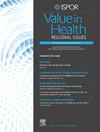Cost-Effectiveness of Aerial Logistics for Immunization: A Model-Based Evaluation of Centralized Storage and Drone Delivery of Vaccines in Ghana Using Empirical Data
IF 1.4
Q3 HEALTH CARE SCIENCES & SERVICES
引用次数: 0
Abstract
Objectives
In mid-2020, the Ghana Health Service introduced Zipline’s aerial logistics (centralized storage and delivery by drones) in the Western North Region to enhance health supply chain resilience. This intervention led to improved vaccination coverage in high-utilization districts. This study assessed the cost-effectiveness of aerial logistics as an intervention to improve immunization coverage.
Methods
An attack rate model, adjusted for vaccination coverage and vaccine efficacy, was used to estimate disease incidence among vaccinated and unvaccinated populations, focusing on 17 022 infants. Incremental cost-effectiveness ratios of US dollar per averted disability-adjusted life-year (DALY) were evaluated from societal and government perspectives, using real-world operations data. Probabilistic sensitivity analysis was performed using Monte Carlo simulations.
Results
In 2021, aerial logistics averted 688 disease cases. Incremental cost-effectiveness ratios were $41 and $58 per averted DALY from the societal and government perspectives, respectively. The intervention was cost-saving when at least 20% of vaccines delivered by aerial logistics replaced those that would have been delivered by ground transportation, with potential government savings of up to $250 per averted DALY. Sensitivity analysis confirmed the robustness of these findings.
Conclusions
Under conservative assumptions, aerial logistics was a highly cost-effective intervention to increase immunization coverage. The intervention was cost-saving even with low levels of replacement of traditional last mile delivery. These findings support expanding aerial logistics within the national immunization program and have significant implications for other low- and middle-income countries seeking cost-effective health supply chain solutions.
航空物流免疫的成本效益:基于模型的评估集中储存和无人机交付疫苗在加纳使用经验数据。
目标:2020年年中,加纳卫生服务局在西北地区引入Zipline的空中物流(集中储存和无人机配送),以增强卫生供应链的弹性。这一干预措施提高了疫苗使用率高的地区的疫苗接种覆盖率。本研究评估了空运物流作为提高免疫覆盖率的干预措施的成本效益。方法:采用发病率模型,对疫苗接种覆盖率和疫苗效力进行调整,估计接种疫苗和未接种疫苗人群的疾病发病率,重点关注17 022名婴儿。使用实际操作数据,从社会和政府的角度评估了每个避免残疾调整生命年(DALY)的增量成本效益比。采用蒙特卡罗模拟方法进行了概率敏感性分析。结果:2021年,航空物流共避免疾病病例688例。从社会和政府的角度来看,每避免DALY的增量成本效益比率分别为41美元和58美元。这一干预措施节省了成本,至少20%的疫苗由航空物流运送,取代了原本可以由地面运输运送的疫苗,每避免一次伤残调整年,政府可能节省高达250美元。敏感性分析证实了这些发现的稳健性。结论:在保守假设下,航空物流是一种高成本效益的提高免疫覆盖率的干预措施。即使对传统的最后一英里配送的替代水平很低,这种干预措施也节省了成本。这些发现支持在国家免疫规划范围内扩大航空物流,并对寻求具有成本效益的卫生供应链解决方案的其他低收入和中等收入国家具有重大意义。
本文章由计算机程序翻译,如有差异,请以英文原文为准。
求助全文
约1分钟内获得全文
求助全文
来源期刊

Value in health regional issues
Pharmacology, Toxicology and Pharmaceutics-Pharmacology, Toxicology and Pharmaceutics (miscellaneous)
CiteScore
2.60
自引率
5.00%
发文量
127
 求助内容:
求助内容: 应助结果提醒方式:
应助结果提醒方式:


